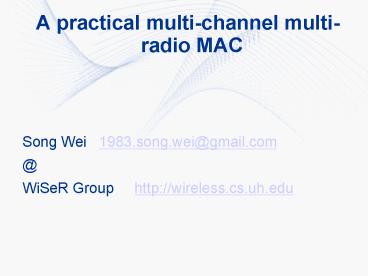A practical multichannel multiradio MAC - PowerPoint PPT Presentation
1 / 22
Title:
A practical multichannel multiradio MAC
Description:
one node is equipped with one packet interface and a busy tone interface ... The bridge between theory and system work is a weak link in current research in this area. ... – PowerPoint PPT presentation
Number of Views:28
Avg rating:3.0/5.0
Title: A practical multichannel multiradio MAC
1
A practical multi-channel multi-radio MAC
- Song Wei 1983.song.wei_at_gmail.com
- _at_
- WiSeR Group http//wireless.cs.uh.edu
2
Introduction
- For multi-channel multi-radio wireless network
(MCMR)? - Distributed
- An up to date MAC framework with a clear design
to handle MCMR - Intelligent Decision Making Compnent
3
Background
- Assumptions
- Multiple interfaces for one node
- Off the shelf hardware
- Number of channels gt Number of interfaces per
node - No centralized control
- Trade offs
- simplicity vs flexibility
- throughput vs delay
4
Motivation
- Intelligent decisions needed in distriubted MCMR
network - Channel switching
- Avoid crowded channels
- Packet scheduling
- Balance among multiple links
- Traditional MAC CSMA/CA
- How to avoid collison when you can't hear from
all the neighbours?
5
Related Work with Numeric Results
- Capacity of MultiChannel Wireless Networks
Impact of Number of Channels and Interfaces,
Pradeep Kyasanur, Nitin H. Vaidya - performance bounds for static multi-channel
wireless network - Decentralized Cognitive MAC for Opportunistic
Spectrum Access in Ad Hoc Networks A POMDP
Framework, Qing Zhao, Lang Tong, Ananthram Swami,
and Yunxia Chen - simpfied assumptions, partial observable markov
chain
6
Related Work with simulation results
- Multichannel MAC Protocols for Wireless Networks,
Ritesh Maheshwari, Himanshu Gupta and Samir R.
Das - one node is equipped with one packet interface
and a busy tone interface
7
Related Work with testbed implementation
- Design and Implementation of a MultiChannel
MultiInterface Network, Chandrakanth Chereddi,
Pradeep Kyasanur, and Nitin H. Vaidya - net-x framework channel/load balancing
abstraction layer above device driver, fixed
interface switchable interface - device driver enhancements for faster channel
switching - MadMAC Building a Reconfigurable Radio Testbed
using Commodity 802.11 Hardware, Ashish Sharma,
Mohit Tiwari, Haitao Zheng - fine grained control over madwifi driver
- McMAC A Multi-Channel MAC Proposal for Ad-Hoc
Wireless Networks, Hoi-Sheung Wilson So, Jean
Walrand - 1 hop ad hoc network with 1 radio per node
- Rendezvous based
8
What's special about us?
9
(No Transcript)
10
An attempt to bridge theory and implementation
PMODP Machine learning ...
NET-X
?
11
Goal
- MCMR MAC framework
- easy linux integration
- hide details from network layer
- fine grained control
- separate basic infranstructure and algorithmic
module - Decision making module
- channel switching, packet scheduling, load
balancing - acheive better distributed coordination between
nodes - utilize detailed wireless statistics
12
Design Choices
- One switchable interface(hopper) one fixed
interface(anchor)? - flexibility vs simplicity
- A bonding driver above device drivers
- hide hardware details
- can handle different devices more easily
- utilize standard wireless interface in current
linux - link level hello protocal
- Update customization upon NET-X work
- Focus on decision making module
13
Improvements upon NET-X
NETX
WiSer MAC
- Add on to bonding driver
- Link level contains routing functionality
- Invokation of scheduling/channel switching code
is simple - Linux 2.4
- Clean slate code
- Link level modification is hidden from upper
level - Flexible ways to invoke scheduling/channel
switching code - Linux 2.6
14
Design Choices
- Decision making module
- Objective
- channel switching
- packet scheduling
- load balancing
- harness RSSI and other detailed wireless info for
every packet
15
System Architecture
Network layer
Linux packet interface
Control utility in user space
Wiser bonding driver
IOCTL
Linux packet interface
Linux wireless framework
Slave Network Driver
Slave Network Driver
16
System ArchitectureWiser bonding driver
Channel switching timer
Packet buffer queue
Packet scheduling channel switching module
Interface/channel assignment interface
wireless device interface
17
System Architecturehello protocol
Hello protocal timer
Hello protocol module
Slave device control
wireless device interface
18
System Architecturemeasurement
wireless device interface
Measurement componenet
Wireless node
Wireless node
Wireless node
Centralized experiment control data gathering
19
Decision Making module
- Design will be driven by measurement result
- May need to be merged with hello module
- Major concerns
- reduction of in-network interference efficient
distributed coordination - capture of external interference/link quality
variation pattern - guess what's happening on other channels with
limited observation - Candidate tools
- markov chain, coding theory, dynamic programming,
Q learning, neural network
20
Decision Making module
- Current idea
- Which channel to switch to
- Bandwitdth expectation
- Load balancing requirement
- Lookihood of channel state estimation
- When to switch
- Current channel state
- Load balancing needs
- Channel switching time
21
Current status
- Done
- Related work survey
- Design goal formulation
- Design choice
- In progress
- Implementation debugging of MAC infranstruture
prototype - ToDo
- Measure throughput delay on testbed
- measurement driven design of decision making
module
22
Conclusion
- The bridge between theory and system work is a
weak link in current research in this area. - This work is both an exploration as well as
ground work for our group - Importance of investment in system development
- Grateful for critiques and suggestions!































